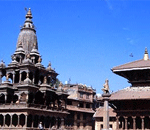
Durbar Square
This is the Royal Palace Complex built during the Malla period and stood as the capital part till the 17th century. Situated in the heart of the city, it constitutes the salient focus of an alien visitor's attraction. The square is built of ancient palaces, temples, shrines and statues noted for their exquisite carvings. We owe all these grandeurs to the sovereign Malla dynasty. The last of the Malla dynasty was late King Tej Narsingh Malla. There include three main courtyards, the first being the Keshab Narayan Chowk which we have gotten to enter through the Golden Gate and under the Golden Window; the second being the Taleju Vawani Chowk; and the third being the Sundari Chowk carrying the Royal Bath called Tushahity. The single stone pillar on which sits late King Yog Narendra Malla facing the Taleju Vawani Temple to the cardinal direction of east and the Gigantic Bell to its right are also worth mentioning. The Patan Durbar Square too forms a World Heritage Site.
Krishna Temple
Built in the 16th century by late King Siddhi Narsingh Malla, this temple is made of pure stone. It is a marvelous structure constructed completely out of stone, except for the few pinnacles or the spires adjusted out of metal. The carvings on its friezes depict battle scenes from the ancient Hindu epics of South Asia, the Ramayan and the Maha-Varat in particular. Opposite remains the single stone pillar with a Garud sitting on, paying decent homage to Lord Krishna.